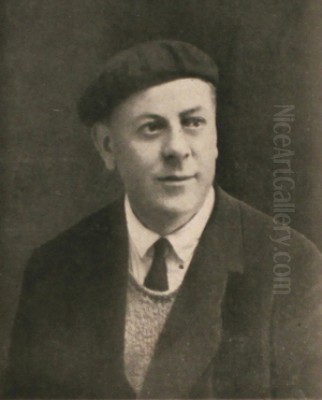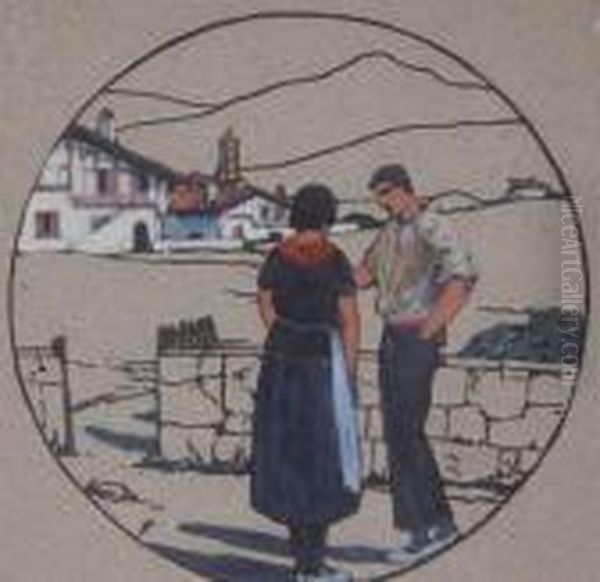
Louis Floutier stands as a significant figure in early 20th-century French regional art, celebrated primarily for his evocative depictions of the Basque Country. Born in Toulouse on March 31, 1882, and passing away in Saint-Jean-de-Luz in 1936, Floutier dedicated much of his artistic life to capturing the unique landscapes, culture, and, most importantly, the luminous quality of light found in this distinct region nestled between France and Spain. His legacy encompasses not only painting but also significant contributions to the art of ceramics.
Early Life and Artistic Formation
Floutier's artistic journey began in his birthplace, Toulouse, a city with a rich cultural heritage in the south of France. He enrolled at the local École des Beaux-Arts, a foundational step for many aspiring artists of the time. Here, he studied under the guidance of the painter Laborde, absorbing the academic principles and techniques that formed the bedrock of traditional art education in France. This initial training would have equipped him with essential skills in drawing, composition, and the handling of paint.
Seeking broader horizons and more advanced training, Floutier made the pivotal move to Paris in 1903. The French capital was then the undisputed center of the Western art world, a vibrant hub of innovation and tradition. He joined the atelier of Fernand Cormon (1845-1924), a highly respected historical painter who, despite his own academic leanings, presided over a studio that attracted a surprisingly diverse range of talented young artists. Cormon's studio was known for its rigorous training but also for fostering a certain degree of artistic exploration.
The Atelier Cormon: A Crucible of Talent
Studying under Fernand Cormon placed Floutier in an environment teeming with emerging talent and diverse artistic currents. Cormon, famous for his large-scale historical and prehistoric scenes, paradoxically mentored artists who would become key figures in modern art. During various periods, his students included luminaries such as Henri de Toulouse-Lautrec (1864-1901), known for his vibrant portrayals of Parisian nightlife, and briefly, Vincent van Gogh (1853-1890), whose expressive intensity would revolutionize painting.

Other notable figures who passed through Cormon's studio around this era included Émile Bernard (1868-1941) and Louis Anquetin (1861-1932), both pioneers of Cloisonnism and Synthetism, styles closely associated with Paul Gauguin (1848-1903). Exposure to such diverse talents and the swirling debates between academic tradition and the avant-garde movements like Impressionism and Post-Impressionism undoubtedly shaped Floutier's artistic perspective, even as he forged his own path.
The Allure of the Basque Country
While Paris offered unparalleled artistic stimulation, Floutier ultimately found his true muse elsewhere. He was drawn to the Pays Basque, the Basque Country, a region renowned for its dramatic coastline, rolling green hills, distinctive architecture, and deeply rooted cultural traditions. He eventually settled in Saint-Jean-de-Luz, a picturesque fishing port that would feature prominently in his work.
What captivated Floutier most profoundly was the region's unique light. In a 1932 interview, he articulated this fascination: "Basque country is the home of light, light here seems particularly pure and rich." This perception became a cornerstone of his art. He sought to translate the clarity, intensity, and atmospheric effects of Basque light onto his canvases, moving beyond mere topographical representation to capture the very essence and mood of the place. His decision to remain there permanently underscores the deep connection he felt to the region.
Artistic Style: Light, Observation, and Impressionist Echoes
Floutier's style evolved throughout his career, building upon his academic foundation while embracing more modern sensibilities. His deep observation of Basque life – the fishermen at the harbor, the bustling markets, the shepherds in the hills, the quiet dignity of rural existence – provided the subject matter. His approach, however, was increasingly informed by the innovations of Impressionism, particularly the movement's emphasis on capturing fleeting moments and the effects of light and atmosphere.
While not strictly an Impressionist in the mold of Claude Monet (1840-1926) or Pierre-Auguste Renoir (1841-1919), Floutier shared their interest in plein air observation and the way light defines form and color. His later work often displays a freer brushstroke and a richer application of paint, sometimes employing impasto techniques where paint is applied thickly to create texture. This aligns with a broader Post-Impressionist sensibility, where personal expression and the structure of the painting gain importance, as seen in the works of artists like Paul Cézanne (1839-1906).

Floutier aimed for a balance between accurate depiction and atmospheric evocation. His paintings convey the tranquility and beauty of the Basque landscape, the vibrancy of its towns, and the character of its people. He wasn't merely documenting; he was interpreting the region through his sensitivity to its visual and cultural nuances, especially its celebrated light.
Representative Works: Windows into the Basque World
Floutier's oeuvre provides a rich visual tapestry of Basque life. Several key works exemplify his style and thematic concerns:
_Flower Market_ (or _Flower market in Saint Jean de Luz_): This painting vividly captures the color and energy of a market day. One can imagine Floutier using lively brushwork and a bright palette to depict the stalls laden with flowers, the interactions of vendors and customers, all bathed in the characteristic Basque light. Such scenes allowed him to explore complex compositions and the interplay of color. An example of this work fetched £2,700 at auction, indicating its appeal to collectors.
_Le port de Saint-Jean-d' light_ (The Port of Saint-Jean-de-Luz): A recurring theme, the port offered Floutier dynamic subjects – fishing boats, nets, the reflections on the water, and the figures of fishermen. A known example, measuring 33 x 25.5 cm and executed in oil, likely focuses on the atmospheric conditions of the harbor, perhaps at dawn or dusk, allowing for dramatic light effects.
_Bouvier basque et Porteuse d'eau_ (Basque Herdsman and Water Carrier): This title suggests a focus on traditional rural figures and occupations. Such works highlight Floutier's interest in the human element of the Basque landscape, portraying the daily lives and perhaps the resilience of its inhabitants.
_La maison basque_ (The Basque House): Executed in watercolor with a diameter of 14 cm, this work likely focuses on the distinctive architecture of the region – the white-washed walls, red or green timbering, and sloping roofs. Watercolor would allow for capturing the subtle play of light on these surfaces.
_Couple de Basques_ (Basque Couple): Another watercolor, larger at 19 cm diameter, this piece probably portrays local people in traditional attire, emphasizing cultural identity. Floutier's skill would lie in capturing their expressions and postures with sensitivity.
_La lumière du pays basque_ (The Light of the Basque Country): This title explicitly states his central preoccupation. While perhaps not a specific, identifiable scene, it suggests works where the primary subject is the quality of light itself – how it falls across the landscape, illuminates the sky, and defines the atmosphere.
These works, whether oil paintings or watercolors, consistently reflect Floutier's dedication to his adopted homeland, rendered with skill and affection.
The Ciboure Pottery Venture: Artistry in Clay
Floutier's artistic expression was not confined to canvas. In 1919, shortly after the end of World War I, he embarked on a significant new venture, co-founding the Poterie de Ciboure (Ciboure Pottery) in the town adjacent to Saint-Jean-de-Luz. His partners in this enterprise were Edgar Lucatel (sometimes cited as Lukas or Luc) and Etienne Vilotte. This move demonstrated Floutier's versatility and entrepreneurial spirit.
The timing coincided with the rise of the Art Deco movement, which often blended traditional craftsmanship with modern aesthetics. The Ciboure pottery quickly gained recognition for its distinctive style, often inspired by classical Greek forms and decoration but infused with Basque motifs and a vibrant color palette. Floutier's background as a painter undoubtedly influenced the decorative aspects of the pottery.
Wartime Experience and Classical Influences
Floutier's interest in ceramics, particularly those with classical influences, may have been significantly shaped by his experiences during World War I. Between 1915 and 1918, he was stationed with the French army in Thessaloniki, Greece. During this time, he participated in archaeological excavations organized by the Army of the Orient. This direct exposure to ancient Greek sites and artifacts, particularly pottery, seems to have left a lasting impression.
Witnessing the forms, techniques, and painted decorations of Greek vases firsthand likely informed the aesthetic direction of the Ciboure pottery. The workshop became known for its hard-paste stoneware, often featuring neo-Greek scenes, figures in Basque attire, or local landscapes, executed with a painterly quality. Examples include pieces from the "Vilotte Series" featuring classical figures, soldiers, and knights, as well as items depicting local scenes like Devant la Croix blanche, Ciboure and Marins et Vendeurs de Mots.
Exhibitions, Recognition, and Connections
Throughout his career, Floutier actively sought to exhibit his work and engage with the broader art community. Between 1905 and 1919, before dedicating himself more fully to the Basque region and the pottery, he participated in the prestigious Salons des Artistes Français in Paris. These annual Salons were major events, offering artists crucial visibility and the chance to measure themselves against contemporaries. Exhibiting there placed his work within the mainstream of French art.
Later, his focus shifted more towards regional venues, with exhibitions held in key towns like Bayonne, Pau, Limoges, and his native Toulouse. This reflected his deep integration into the artistic life of Southwestern France and the Basque Country. He also established his own art gallery in Saint-Jean-de-Luz, providing a dedicated space to showcase his work and likely that of other regional artists.
His connections extended from his teachers (Laborde, Cormon) and collaborators (Lucatel, Vilotte) to the wider circle of artists he encountered in Paris and through exhibitions. While perhaps not a radical innovator on the scale of Pablo Picasso (1881-1973) or Henri Matisse (1869-1954), Floutier was a respected professional who carved out a distinct niche, earning the admiration of collectors and critics who valued his sensitive portrayals of the Basque region. His work was compared favorably to other artists focused on regional identity, though his style remained distinctly his own.
Legacy and Enduring Appeal
Louis Floutier died in 1936 at the relatively young age of 54, but he left behind a substantial body of work in both painting and ceramics. His primary legacy lies in his contribution to the artistic representation of the Basque Country. He was more than just a landscape painter; he was an interpreter of a culture and an environment, capturing its unique light, traditions, and atmosphere with sincerity and skill.
His paintings continue to be appreciated for their evocative beauty and technical proficiency. They offer valuable glimpses into Basque life in the early 20th century. His works are held in private collections and likely in regional museums, and they appear periodically at auction, demonstrating continued market interest.
The Ciboure pottery, which he co-founded and artistically influenced, also represents a significant part of his legacy, contributing to the rich tradition of French art ceramics. The pottery produced during his time is sought after by collectors of Art Deco and regional ceramics.
In the broader narrative of French art, Louis Floutier is recognized as a prominent regionalist painter. He stands alongside other artists who found profound inspiration in specific locales, choosing deep engagement with a chosen place over the metropolitan allure of Paris. His dedication to the Basque Country resulted in a body of work that celebrates its enduring charm and visual splendor, securing his place as one of its most devoted artistic chroniclers. His ability to translate the "pure and rich" light of the Pays Basque into compelling works of art remains his most distinctive achievement.